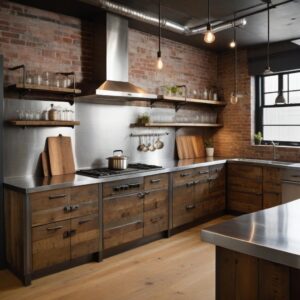The allure of the industrial interior design style lies in its celebration of raw beauty and functional aesthetics. Originating from the transformation of old factories and warehouses into living spaces, industrial design brings a unique charm that combines rugged textures with modern touches. In this blog post, we’ll explore the key elements of industrial interior design and how you can incorporate them into your home to create a space that is both stylish and practical.
The Origins of Industrial Design
Industrial interior design finds its roots in the early 20th century when factories and warehouses were converted into residential and commercial spaces. The style emerged as a necessity rather than a choice, making use of the existing structures’ bare bones. Today, it has evolved into a popular aesthetic, revered for its raw and unfinished look, and its ability to blend the old with the new.

Key Elements of Industrial Interior Design
Exposed Structural Elements
- Bare Walls: Brick, concrete, or steel walls are left exposed to showcase the building’s original structure. These raw textures add a sense of authenticity and history to the space.
- Visible Ductwork and Pipes: Instead of hiding mechanical elements, industrial design embraces them as part of the decor. Exposed pipes and ductwork add to the industrial charm.
Open Floor Plans
- Industrial spaces often feature large, open layouts that mimic the expansive nature of warehouses. This creates a sense of flow and spaciousness, perfect for modern living.
Utilitarian Furniture
- Furniture in industrial design is functional and often features clean lines and sturdy materials. Metal, wood, and leather are commonly used, with a preference for pieces that have a worn or aged look.
Neutral Color Palette
- The industrial style favors a neutral color scheme dominated by grays, blacks, whites, and browns. These colors complement the raw materials used and create a cohesive, grounded look.
Reclaimed and Repurposed Materials
- Sustainability is a key aspect of industrial design. Reclaimed wood, repurposed metal, and salvaged furniture pieces add character and reduce environmental impact.
Industrial Lighting
- Lighting plays a crucial role in industrial interiors. Think oversized pendant lights, Edison bulbs, and metal fixtures. These elements not only provide illumination but also enhance the industrial vibe.



Incorporating Industrial Design into Your Home
Start with the Basics: Begin by exposing any brick or concrete walls you may have. If this isn’t possible, consider using wallpaper or paint that mimics these textures. Embrace the structural elements of your home – leave beams, pipes, and ducts visible where feasible.
Choose the Right Furniture: Opt for furniture that embodies the industrial spirit. Look for pieces made from metal and wood, such as a metal-framed coffee table or a reclaimed wood dining table. Mix and match with vintage finds to add a personal touch.
Accessorize Thoughtfully: Add industrial-style accessories to your space. Think metal clocks, vintage signs, and factory-style shelving units. These small touches can significantly enhance the industrial feel.
Light it Up: Select lighting fixtures that complement the industrial aesthetic. Pendant lights with exposed bulbs, floor lamps with a mechanical design, and metal sconces can all contribute to the look.
Add Greenery: Balance the raw, rugged feel of industrial design with some greenery. Potted plants and vertical gardens can soften the hard edges and bring a touch of nature indoors.
Mix and Match: Don’t be afraid to blend industrial elements with other styles. Industrial design pairs well with rustic, modern, and even minimalist aesthetics. Mixing styles can create a unique and personalized space.


Industrial interior design is more than just a trend; it’s a homage to the beauty of raw materials and functional spaces. By embracing exposed structural elements, choosing utilitarian furniture, and maintaining a neutral color palette, you can create a home that is both stylish and deeply connected to its architectural roots. Whether you’re renovating a loft or just want to incorporate some industrial touches into your home, this design style offers endless possibilities for creativity and expression.
Ready to embrace the raw beauty of industrial design? Start small with a few key pieces or go all out with a complete makeover. Either way, you’ll be creating a space that is uniquely yours, steeped in history and style!

Leave a Reply